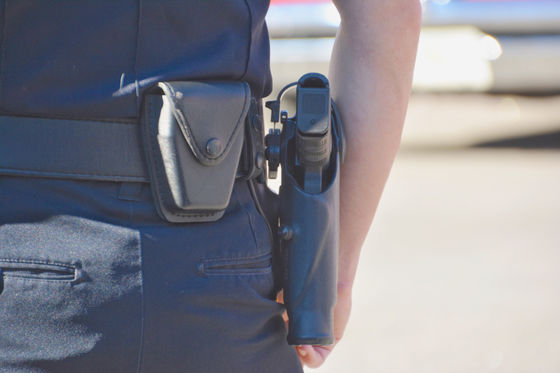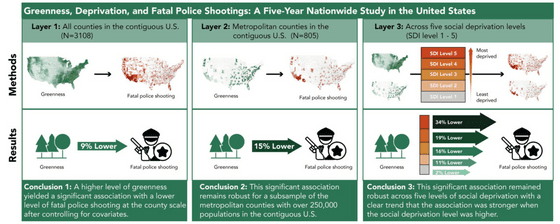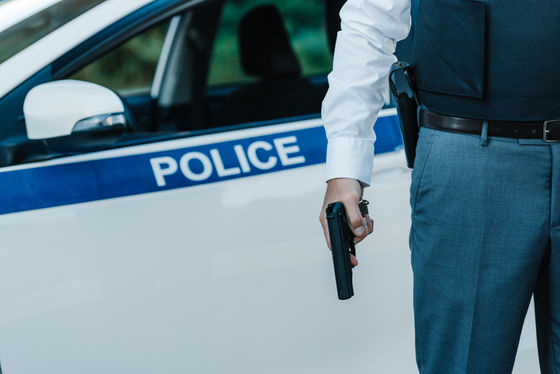A surprisingly strong correlation was found between the amount of greenery in a neighborhood and police shootings.

In the United States, where gun crime is rife, shootings by police officers as well as criminals are a serious social problem. Meanwhile, past research has shown that the abundance of nature, such as street trees and parks, is closely related to
Greenness, Deprivation, and Fatal Police Shootings: A Five-Year Nationwide Study in the United States - Jiali Li, Matthew E. Browning, William C. Sullivan, Xueming Liu, Bin Jiang, 2025
https://journals.sagepub.com/doi/10.1177/00139165251316106
New study finds link between green spaces and police violence – News Bureau
https://news.illinois.edu/new-study-finds-link-between-green-spaces-and-police-violence/
Surprisingly strong link found between neighborhood greenness and police shootings
https://www.psypost.org/surprisingly-strong-link-found-between-neighborhood-greenness-and-police-shootings/
Intrigued by the repeated reports of serious police shootings in the United States, a research team led by Associate Professor Bin Jiang of the University of Hong Kong analyzed the relationship between cases in which police shootings escalated into life-threatening incidents and the natural environment of the areas where these incidents occurred.
First, the research team searched three geographic databases of police violence for police shootings that occurred in 3,108 counties across the United States between 2016 and 2020 and extracted more than 5,000 cases in which a person was shot to death.

To quantify the amount of greenery in an area, the team used data from the Earth observation satellite
In addition, to analyze broader social factors, a 'social poverty index' reflecting factors such as poverty level, education level, and unemployment rate was also examined. The analysis also took into account a variety of factors that may affect police shootings, such as demographics, economic conditions, violent crime rates, gun laws, firearm ownership rates, human behavior patterns, the degree of racial segregation, and the level of urban development.
They found a consistent pattern in which greater green space was associated with fewer fatal police shootings. Specifically, each one-unit increase in the green space index was associated with a 15% decrease in police shootings. Importantly, this negative association persisted even after controlling for crime rates, population density, and socioeconomic indicators.

By William Sullivan
'To our knowledge, this is the first study to report a significant association between fatal police shootings and greenery. This association remained robust even after controlling for many confounding factors, suggesting that the quantity and quality of landscapes are important in creating safer neighborhoods and towns,' said Jiang. 'Controlling for confounding factors is crucial because many citizens often attribute such associations to chance. In addition, our study found that this association was independent of race, income, population density, Gini coefficient, gender, age, unemployment rate, and many other factors.'
The researchers also found that the association between green space and police shootings varied by county deprivation, with green space having the most significant effect on reducing fatal police shootings in the highest-poverty counties.
Additionally, the negative correlation between fatal police shootings and green spaces was stronger in urban counties than in non-urban counties, suggesting that the effect of green spaces may be greater in more urbanized areas.
The research team proposed several hypotheses for these results. First, it is possible that green spaces reduce stress and anxiety not only among residents but also among police officers, lowering the likelihood of aggressive encounters.
Green environments may also give the impression of a neighborhood being well-maintained and safe, which may influence officers' perception of risk. Additionally, green spaces often foster social interaction and community cohesion, which may in turn increase social control and reduce the likelihood of escalating incidents that lead to police intervention.

The authors acknowledge that the study has several limitations. First, the relationship between green space and police shootings is correlational; it does not prove a causal relationship, such as 'more green space directly reduces police shootings.' Additionally, the research team controlled for a variety of variables, but it's possible that unidentified factors could be influencing the results. Additionally, the data used in the analysis was collected from open-source records, which may be incomplete or reported inconsistently across jurisdictions.
Despite these challenges, the researchers say their findings support a broader view of community safety.
'Let's create more green spaces and reduce wasteland. Green spaces can promote social interaction and recreational activities, and also foster greater social cohesion and trust among residents, governments and other stakeholders,' said Jiang.
In future studies, the team plans to look more specifically at the types of green spaces that are most important, such as parks and street trees, and evaluate how people perceive and interact with these environments.
Related Posts:
in Science, Posted by log1l_ks







